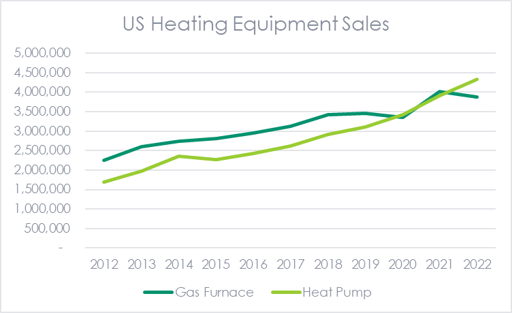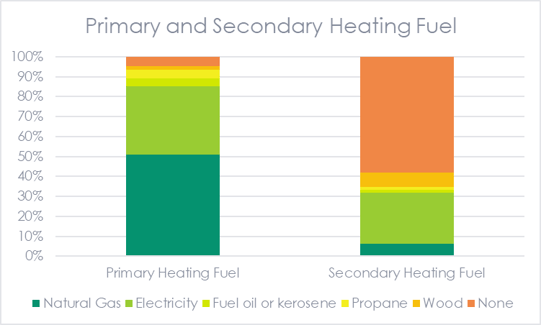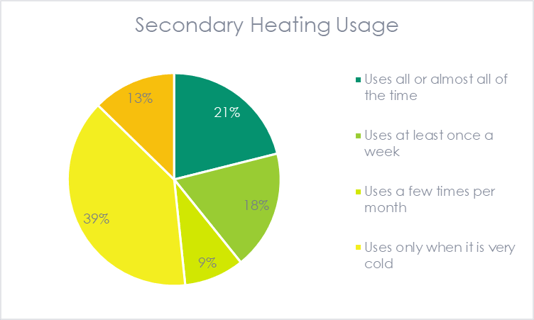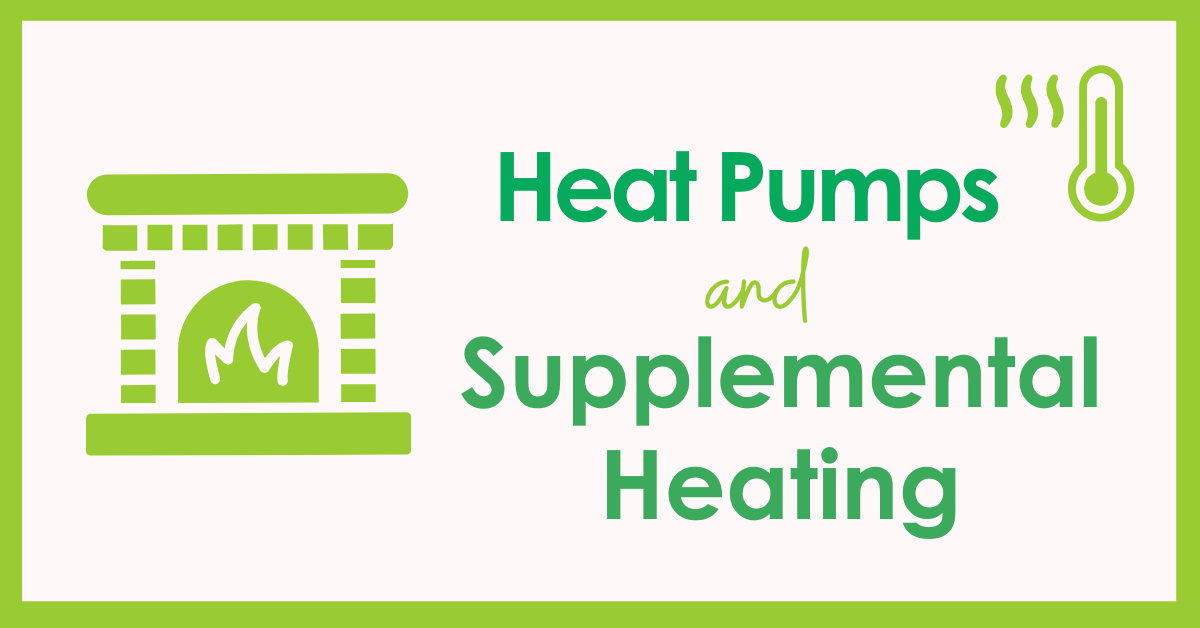Heat Pumps and Supplemental Heating
In case you haven’t heard, heat pumps are a thing now. As their efficiency and performance in cold climates continue to improve, heat pumps have become the backbone of energy efficiency and decarbonization efforts and are a focal point of the Inflation Reduction Act. The penetration of heat pumps has steadily increased to a majority of new equipment sales. Given heat pumps' increased share of installations, we need to understand their impact, especially when paired with supplemental heating equipment. But what is supplemental heating and how does it differ from primary, backup, and emergency heating? It wasn’t clear to me, so I decided to look into it.

Source: AHRI
Primary v. Secondary v. Supplemental v. Backup v. Emergency Heating
Most baseline studies ask about homes’ primary and secondary heating equipment. For example, the EIA’s Residential Energy Consumption Survey (RECS) found that 51% of US homes used natural gas as their main heating fuel, 43% of homes has a central natural gas furnace as their main heating equipment (85% of homes with natural gas) and about 15% of homes have a heat pump. The chart below shows the primary and secondary heating fuel in US homes from the 2020 RECS.

Source: EIA 2020 Residential Energy Consumption Survey
Baseline studies also typically ask about how often secondary heating is used. The chart below shows the results from the 2020 RECS.

Source: EIA 2020 Residential Energy Consumption Survey
For high-level penetration and saturation findings, this level of detail is adequate. But for more complex analysis, understanding the hierarchy of heating systems becomes important. Although it seems that everyone has slightly different definitions, I would describe different types of heating like this:
- Primary Heating – Equipment that provides the majority of heating (e.g., a furnace, boiler, or heat pump). Easy.
- Secondary Heating – Any equipment that is not the primary heating equipment; an extra heat source. Easy.
- Supplemental Heating – Equipment that provides the additional heating capacity to the primary heating equipment when needed (e.g., electric baseboard heaters, wood stoves, space heaters, a mini-split heat pump, electric resistance elements in a heat pump, a furnace in a dual fuel heat pump system). I would think of this as the equipment you would use in shoulder seasons when the main equipment isn’t running yet or the things you would use to make a space more comfortable on a winter night. This would include using electric resistance heating in a heat pump while running the compressor.
- Backup Heating – Equipment that can provide (near) full capacity if the primary heating can’t handle it. (e.g., electric resistance elements in a heat pump, a furnace in a dual fuel heat pump system, a wood stove) This would include the equipment that you would use in very cold winter weather or when there is a power outage.
- Emergency Heating – This is essentially the same as backup heating, but specifically for heat pumps that lock out the compressor and rely on auxiliary heat (either electric resistance elements or a furnace) for all heat.
As the astute reader will see, there is a lot of overlap between these different categories, potentially leading to confusion. Feel free to contact me with your own definitions!
Why Does This Matter?
As everyone knows, heat pumps work (really efficiently!) by using a compressor and refrigerant to extract heat from the air (cold air outside in the winter) and moving it somewhere else (like inside your house). However, as the temperature outside decreases, it is harder for the system to extract that heat, and it pumps less heat into the house. Meanwhile, heat from inside your home is lost through the building shell, and more heat is needed to replace it. In other words, the heating load is going up, and the heating capacity is going down. At some point, the heating load will become greater than the heating capacity, and supplemental heat be needed to maintain the internal temperature. This is called the balance point. Heat pumps have historically been maligned for not being able to perform well at lower temperatures (e.g., below 32F), but newer cold climate heat pumps can perform very well at temperatures below 0F.
At some point, the outdoor temperature will reach a “switchover temperature” when the heat pump compressor should turn off because it is too inefficient, and backup heat should be used to minimize total utility costs. This temperature will depend on the efficiency of the heat pump, the type and fuel of the backup heating equipment, and the cost of electricity and the backup fuel.
In all of the examples so far, we have discussed using the heat pump as the primary equipment, with other equipment serving as supplemental or backup equipment. However, in many cases, the home still has a fossil fuel central heating system and uses ductless mini-split heat pumps as the supplemental heating system.
Regardless of the configuration, it is important to know how the different heating systems interact with each other as it will impact the home’s energy use and utility bills. For example, electric demand will vary dramatically depending on if the heat pump is the primary or supplemental heating equipment, if there is supplemental or backup equipment, and what the balance point and switchover temperature of the system are. As utilities in colder climates potentially shift to a winter peaking load shape, it will be very important to understand if a home is using exclusively electric resistance heating on a frigid January morning or if it is relying on a backup gas furnace, or if a heat pump and furnace are working together. Recognizing this, utilities have expanded their TRMs to include multiple options for heat pump configurations but rely on custom calculations for dual-fuel systems.

